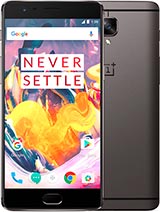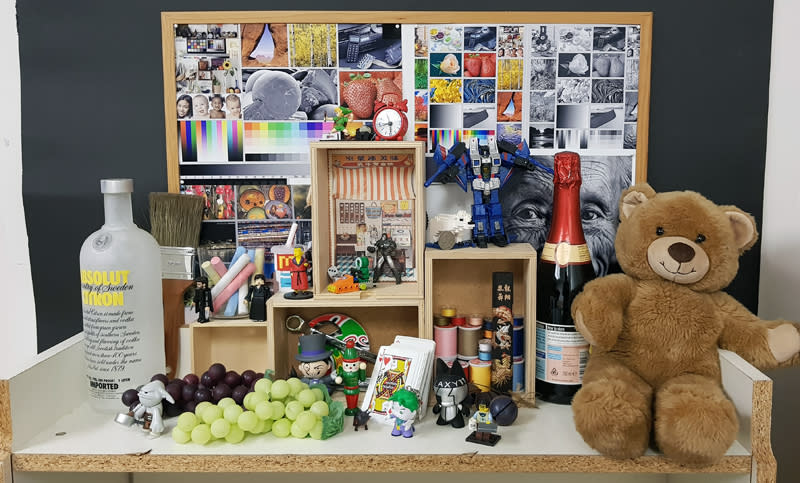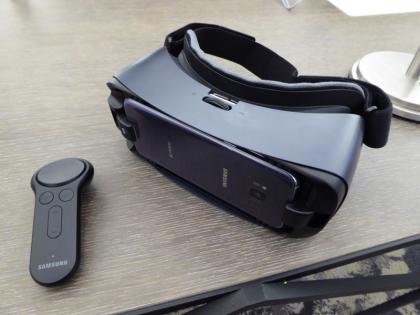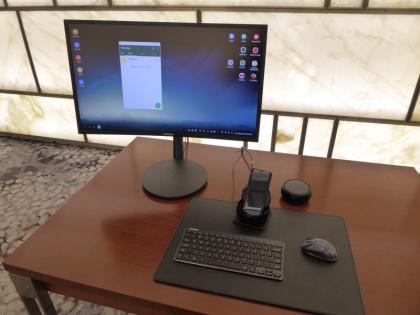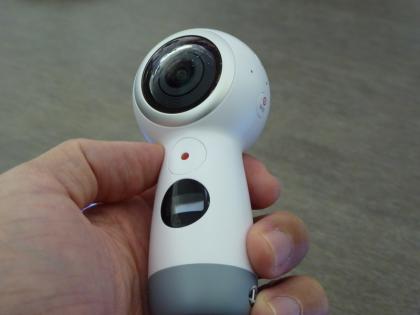Samsung Galaxy S8 and S8+ review: The future is here
Note: This review was first published on 21st April 2017.
Overview
The Galaxy S8 and S8+ are the most important phones Samsung has ever made. In case you've been living under a rock for the past six months, Samsung's last phone, the Galaxy Note7, was a complete disaster, thanks to a crucial design flaw that caused its battery to spontaneously catch fire and explode. In an unprecedented move, Samsung had to recall the phone twice, and was eventually forced to cancel the device entirely, handing out refunds to millions of customers, and costing the company billions of dollars in the process.
Now, Samsung doesn't just need to make a phone good enough to beat the competition, it needs to make a strong statement that it's so good that people are willing to forget that at one point it was a federal crime in the US with a ten-year jail sentence for anyone caught with a Note7 on board a plane.
It's an unenviable position that no company has ever had to come back from before. But you know what, I think the S8 and S8+ are actually good enough that Samsung can do it.
|
| |
|
| |
|
| |
|
| |
|
| |
|
| |
|
| |
|
| |
|
| |
|
| |
|
| |
|
|
Design
The newest trend in smartphones is cramming a large display into a small body by eliminating as much of the front bezel as possible. Xiaomi was the first to do it with the Mi Mix, followed by LG with the G6. But shrinking the front bezel isn't enough for Samsung, who has also doubled up on the big screen effect by making the S8 and S8+ displays curved on both edges - yep, Samsung is all-in on curved displays this year, there's no longer a flat screen option. In fact the only difference between the two phone models is the display size and battery size.
Samsung is calling this new design an "Infinity Display" and it really does look incredible. With no physical buttons on the front, tiny bezels at both the top and bottom, and a display that covers almost the entire front of the phone and cascades over the sides like an infinity pool, it really feels like you're holding just a display in your hand. In fact both the S8 and S8+ boast a pretty incredible 83% screen-to-body ratio (the iPhone 7 Plus is just 67.9%, while the recent LG G6 manages an 80% figure).

Those curved edges aren't just for looks either, the curve allows Samsung to squeeze a wider display into a narrower body, making it easier to use one-handed than a similar size flat phone. The LG G6 for example, while boasting a similar bezel-less design, has a smaller 5.7-inch flat display, but with a body that is 3.8mm wider than the S8.
Of course, without a physical home button, that means there's no fingerprint scanner on the front of the phone. Instead, Samsung has moved the scanner to the rear of the device, similar to what Google, Huawei, and LG among others already do.

Unfortunately, while most rear fingerprint scanners are positioned in the middle of the phone below the camera where your index finger naturally rests, Samsung has instead bizarrely chosen to place it right next to the camera module, which is far too high up, awkward to hit and often results in fingerprint smudges on the camera lens as you hunt around for the scanner.
I would really like to see more companies follow LG and Sony's example and put the fingerprint scanner on the power button. On the bright side, you rarely need to use the fingerprint scanner because Samsung has included two other forms of biometric security: Iris scanning and face recognition (more on those later).

Aside from the awkwardly-placed fingerprint scanner, the rest of the S8 and S8+'s design is pretty much flawless. Similar to the Note7, both phones have a gorgeous symmetrical build with an aluminum frame and a rear glass panel that curves at both sides to match the front. The days of ugly protruding camera bumps are also long gone, and the rear camera is now completely flush with the phone.
The power button, as usual, can be found on the right side of the S8's skinny frame, while the volume buttons are on the left. A new addition is a dedicated Bixby button (Samsung's new AI assistant) below the volume buttons.

Both the S8 and S8+ have a USB Type-C port on the bottom and (hurrah!) a standard 3.5mm headphone jack. A dual SIM card tray can be found on top, with the second nano-SIM slot doubling up as a microSD card slot. And like last year's S7, both the S8 and S8+ are IP68 rated, which means they can withstand up to 1.5 meters of water submersion for up to 30 minutes at a time.

Finally, Samsung is introducing a new color for the S8 and S8+. Along with the usual Midnight Black, Maple Gold and Arctic Silver (which won't be available locally at launch) is a new Orchid Gray color, which is a sort of gunmetal gray with a slightly purplish hue. Samsung's gorgeous Coral Blue color also makes a return, but as usual, it won't be available at launch.

Display
Like last year's S7, both the S8 and S8+ use QHD Super AMOLED panels, but by eliminating the physical buttons and stretching the displays, Samsung has had to adopt a new 18.5:9 aspect ratio that makes the S8 and S8+ taller and skinnier than the vast majority of smartphones out there with traditional 16:9 screens. On the Galaxy S8, you get a 5.8-inch 2,960 x 1,440 pixels display (570ppi), while the S8+ has a 6.2-inch 2,960 x 1,440 pixels display (529ppi).
Now to be fair, while those specs make the displays sound absolutely massive - and it's true they are much larger than phones of a similar size - they're slightly misleading, because when the aspect ratio changes, the total screen area also changes, so the S8's 5.8-inch screen is actually smaller in total area than a 5.8-inch screen with a 16:9 ratio. Measuring the dimensions of the S8's display confirms this: its 132 x 64mm screen results in a total screen area of 845mm², whereas Samsung's old 5.8-inch Galaxy Mega, which has a 16:9 screen ratio, has dimensions of 128 x 72mm, resulting in a screen size of 922mm². So don't be disappointed if you buy an S8 or S8+ and the display isn't as big as you anticipated.
The unusual screen ratio also poses a problem with app and content compatibility. Most apps and the majority of content is made for 16:9 ratio, so you often have to deal with content that is either cropped at the sides, or has black bars at the edges. Most games in particular, play with black bars at the side, so you don't get to use all of the S8's screen space.
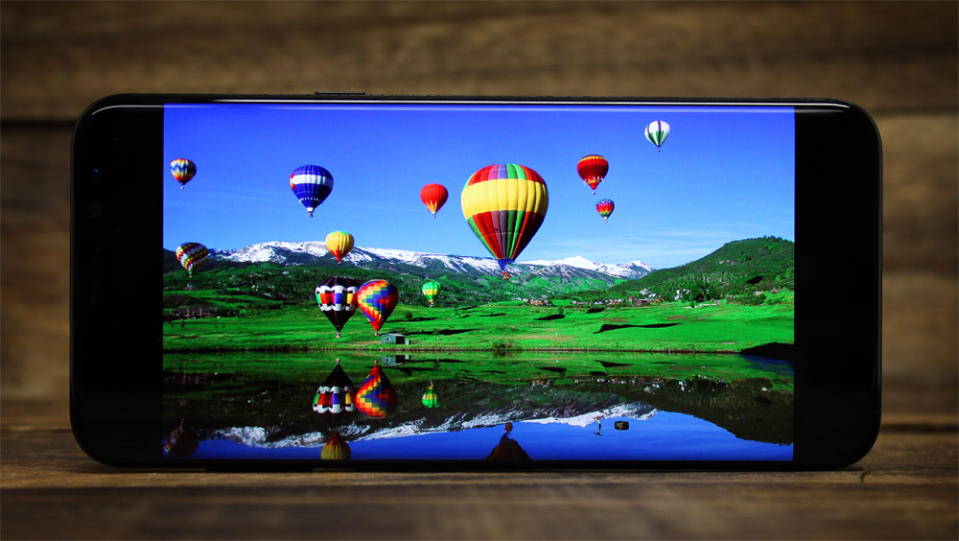
Now there is some 21:9 content out there that looks fantastic on the S8, but even that isn't perfect, with black boxes at the top and bottom (although this is where the screen curves over the edge anyway). This problem may only be temporary anyway, as Google has recently started encouraging developers to support a widescreen aspect ratio on their apps.
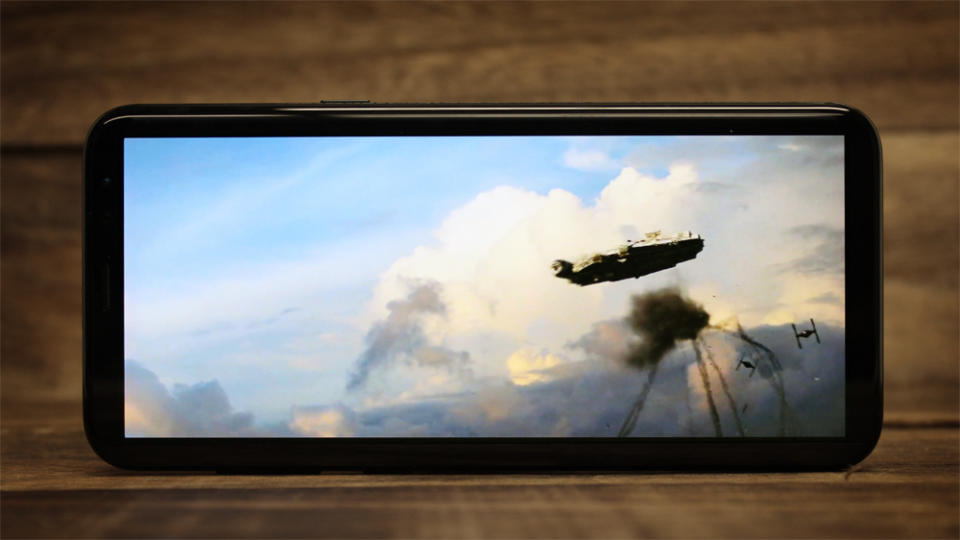
As for the screen itself, Samsung's Super AMOLED panels are among the best in the business, and the S8 and S8+ are no exception. Both displays are sharp, vibrant and very bright, making them easy to use even under direct sunlight. As usual, contrast is also fantastic with ultra deep blacks. The displays are also ‘Mobile HDR Premium’ certified, so you’ll be able to stream HDR (high dynamic range) shows from Amazon Prime and Netflix when those apps are updated.
Like last year's S7, the display is an always-on panel, so you'll see the time, date, battery life and any notifications when you're not using the phone. Edge panels are also back; if you swipe in from the curved right side of the phone (if you're a lefty you can change it to the left side) you'll get access to more app shortcuts, contact shortcuts and other tools including news feeds, Quick Tools (which includes a compass and ruler), Reminders and Smart Select, which lets you easily capture part of the screenshot as a screenshot or animated GIF.

An interesting new addition to the display is a spot of pressure sensitivity right over the virtual home button. You can push harder on this spot of the screen to wake the display or return to the home screen at any point, even when you're using a full screen app that doesn't have a home button displayed. It's somewhat similar to the iPhone's Force Touch feature, but localized to just the spot on the display where the home button resides. It's a thoughtful little feature that works well and will help users transition away from a physical home button.
While we're on the topic of virtual buttons on the bottom of the display, for the first time, Samsung now allows you to swap the position of the 'back' and 'app multi-tasker' buttons! This is a boon for anyone upgrading from other Android brands and not having to to re-adapt to Samsung's preferred button placement.
Audio
Audio on the S8 comes from a single downward-firing speaker found on the bottom of the phone. It's the one area where Samsung hasn't really kept up with the competition, many of which boast stereo speakers. I actually would have preferred if Samsung had used the same speaker placement it experimented with on the mid-range Galaxy A7 (2017), which had the speaker on the right-side, next to the power button. At least this way your hand doesn't cover the speaker when you're holding the phone in landscape orientation. The speaker itself is fairly good, but isn't as loud as the one on an iPhone 7.
You also get a pair of AKG-branded earphones in the box. The earphones are pretty decent, and better than most stock earphones, but they're probably not worth the S$140 Samsung claims they are.
UI
The S8 and S8+ run on Android 7.0 Nougat with Samsung's new Dream UX on top of it. Dream is a progression from Grace UX, which we saw on the Note7 and A7 (2017). If you haven't seen a Samsung phone in a while, you'll be in for a pleasant surprise as the software is both restrained and tasteful, with a simple home screen, and a small tray of app shortcuts. There's no icon for the app drawer by default (although you can add it back in the Settings menu) but if you swipe on the screen, it will load the app drawer. Swipe up again and you're back to the home screen.


Like Grace UX, there's a search bar in the app drawer and settings menu, so it's easy to find anything you need. Dig deeper into the settings and there are customization options for nearly everything, from the order and functionality of the on-screen buttons to themes, and settings for the always-on display.
Bixby Assistant
The big new software feature for the S8 is Bixby, Samsung’s new virtual assistant. Samsung thinks Bixby is such a big deal that it's put a dedicated button on the S8 that does nothing but launch Bixby - you can't even re-program it to do anything else.
Bixby is made up of three features: Bixby Home, Bixby Vision, and Bixby Voice.
Unfortunately, Bixby Voice, which will let you talk to Bixby and issue it commands won't be available at launch. When it is up and running, you'll be able to ask Bixby to do things like search the internet, play a song, dim the screen, and turn on Wi-Fi, all with your voice. It's basically everything you can already do with Google Assistant (which is also available on the phone).
Pressing the Bixby button launches Bixby Home, which is basically Samsung's version of Google Now, and displays various cards and information based on your routine and interests. It will display the weather, any upcoming calendar appointments or reminders you've set and any news updates you've subscribed to. It can also sync with third-party services like Twitter and Facebook. Samsung says that Bixby also has machine learning that will learn your habits and adapt over time, offering suggestions based on your routine but I haven't noticed anything like this popping up yet during my usage period.

Bixby's most interesting feature is Bixby Vision, which resides in the camera and gallery app. This is basically Samsung's version of the Google Goggles app. Point the camera at something, hit the Bixby button (it looks like a stylized eye) and it will identify the object, place or text you're looking at.

It can translate the text you're looking at, or show you similar images on Pinterest, or if you're looking at a landmark, it can use Foursquare to show you more information about that landmark, as well as any nearby points of interest. One thing I did notice is that Bixby cheats a bit with local areas of interest. It doesn't actually show you areas near to the landmark you've taken a picture of, instead it just uses GPS to locate you and show you nearby things, so when I loaded up a picture of Marina Bay Sands on my computer at work and then took a picture of that, it tried to suggest me restaurants near my office.

There's also a dedicated wine button if Bixby detects you're pointing the camera at a bottle of wine. Powered by Vivino, Bixby will show you user ratings for that particular bottle of wine as well as current prices for it. It seems strangely specific to have a feature dedicated just to wine, but it does serve as a preview of how Bixby's shopping functions will work when they're up and running. In the US, Samsung has partnered with Amazon so, for example, if you take a picture of a pair of shoes, it will send you to Amazon with an option to buy that exact same pair of shoes. Unfortunately Samsung is still finalizing the details of it shopping partners in Singapore, so that feature won't be available until after launch.

Right now, while Bixby has lots of potential, it doesn't really offer enough to supplant Google Assistant or the various other Google apps that do the same thing better. But it's definitely a work in progress, so for now, I'll give Samsung the benefit of the doubt, and give it some time to develop it over the coming months.
Biometric Security
Iris scanning first debuted on the Note7, and I'm glad to see it back on the S8. Like the Note7, the S8 has a dedicated iris sensor on the front of the phone with an infrared LED that works in conjunction with the front camera. The LED directs a beam of near-infrared light at your eyes and scans the pattern of your irises. Infrared light is used because it exposes the pattern of the iris much more clearly, making it easier for the sensor to capture it and, as an added bonus, means the iris scanner can work in the dark. It also means that glasses and contact lenses won't affect the beam. Once the image has been recorded, software translates the iris' pattern into code. This code is then compared against a record in search of a match.

Setting up the iris scanner is incredibly easy and is actually faster than setting up your fingerprints, but you'll have to remove your glasses to do so. Once everything is setup however, you can unlock your phone without taking your glasses off. When you unlock your phone, two circles will show up on screen. You're supposed to line up your eyes with these circles but I've found that just vaguely looking in the general direction of your phone will do the trick, and all it needs to do is catch one eye to unlock. The iris scanner is lightning fast, and is just as secure as the fingerprint scanner - you won't be able to fool it with a picture of your eyes.
Once you've setup the iris scanner on the Galaxy S8 series, there's also this really weird option to add an overlay to the scanning screen, just in case you want to pretend to be a cat or something while you're unlocking your phone. Maybe it's a Korean thing?

A less secure, but even more convenient way of unlocking your phone is the S8's new face recognition feature (well, it's new on a Samsung device, but not so for some other Android devices). It's a lot more low-tech, and simply compares the image from the front-facing camera with the one it has on file from when you setup facial recognition. Face recognition and Iris scanning can't be used at the same time and, unsurprisingly, face recognition can be fooled fairly easily with a picture placed at the right angle in front of the phone and, as such, Samsung won't let you use it for Samsung Pay or even your Secure Folder. Despite this, I really enjoyed facial recognition because of how fast it unlocks your phone. I had to check multiple times to make sure I still had security set up because as soon as you wake your phone it will immediately unlock as long as nothing is obstructing the front camera - you don't even need to be looking at your phone, it just needs to see your face.
Performance Benchmarks
As usual there are two versions of the S8 and S8+, the US gets Qualcomm's Snapdragon 835 processor while the rest of the world uses Samsung's own Exynos 8895 SoC. In the past, Samsung's chips have outperformed Qualcomm's, so I'm perfectly fine with this. The new 8895 is built around a cutting-edge 10nm process and features four of Samsung's Mongoose M2 cores running at 2.3GHz and four ARM Cortex A53 cores running at 1.7GHz. It also sports ARM's new Mali G71 GPU clocked at 550MHz. Let's get down to comparing how it ranks in some of the core benchmarks.
|
|
|
|
|
| |
|
|
|
|
|
| |
|
|
|
|
|
| |
|
|
|
|
|
| |
|
|
|
|
|
| |
|
|
|
|
|
| |
|
|
|
|
|
| |
|
|
|
|
|
| |
|
|
|
|
|
| |
|
|
|
|
|
| |
|
|
|
|
|
| |
|
|
|
|
|
|
Sunspider Javascript
SunSpider JavaScript measures the browsing performance of a device when processing JavaScript. It not only takes into consideration the underlying hardware performance, but also assesses how optimized a particular platform is at delivering a high-speed web browsing experience.
The S8 and S8+ were both slightly faster than last year's models, and much faster than the Qualcomm Snapdragon 821-powered OnePlus 3T. Having said that, Apple is still unbeaten in this benchmark.

Quadrant
Quadrant is an Android benchmark that evaluates a device's CPU, memory, I/O and 3D graphics performances. We didn't see that much of an improvement here, although that's just a testament to how good last year's Exynos processors were. It's also worth noting that the S8 scored slightly higher than the S8+, just like the S7 did compared to the S7 Edge.

3DMark Sling Shot
3DMark Sling Shot is an advanced 3D graphics benchmark that tests the full range of OpenGL ES 3.1 and ES 3.0 API features including multiple render targets, instanced rendering, uniform buffers and transform feedback. The test also includes impressive volumetric lighting and post-processing effects. We're running this benchmark in Unlimited mode, which ignores screen resolutions.
This is the benchmark where we saw the biggest gains, with both devices recording monster scores. Last year, only Apple's A10 Fusion chip scored anywhere close to 3000 and now both the S8 and S8+ have easily surpassed it.
Imaging
Specs-wise, Samsung hasn't changed much with the S8's rear camera, which seems to use the same 12-megapixel f/1.7 shooter as last year's S7. According to Samsung, the software processing has been improved to provide better images in low light, but I didn't notice much difference in image quality between the S8 and S7.
That's not necessarily a bad thing, the S7 had one of the better cameras of 2016, even if Samsung did pass on the whole dual-lens fad (Huawei's P10 sports this, so does LG G6, iPhone 7, the upcoming ASUS ZenFone Zoom S and more). To quick launch the camera you can now double press the power button (a feature that's actually been around since Android 6.0 but only now available on Samsung phones). Samsung's default camera app is easy to use, and if you want manual controls, Samsung's Pro mode offers a DSLR-like experience with options to manually set ISO, shutter speed, focus, white balance and exposure. There's also a Selective Focus mode that mimics bokeh background blurring, and lets you adjust the focal point after you've taken the picture but, as is normally the case with this kind of software processing, it's a bit hit-or-miss.
The front camera has been improved, and is now a higher-resolution 8-megapixel shooter with autofocus, which is apparently something that front-facing cameras have never had before. The autofocus works pretty well, and means you don't have to tap the screen to focus on your face.
Image quality from the S8's rear camera is consistently good, with crisp details across the entire image, accurate colors and good contrast. Low-light performance is also surprisingly good, with relatively bright photos, reasonably fast auto-focus and an acceptable amount of noise.


Battery Life
Our standard battery test for mobile phones has the following parameters:
Looping a 720p video with screen brightness and volume at 100%
Wi-Fi and Bluetooth connectivity turned on
Constant data streaming through email and Twitter
Samsung has understandably been a little conservative with the batteries inside the S8 and S8+, with a 3,000mAh battery on the S8 (the same size as the S7) and a 3,500mAh battery on the S8+ (slightly smaller than the S7 Edge's 3,600mAh battery). Recently, Samsung has been trying to allay fears of the S8 suffering the same fiery fate as the Note7 by publicizing its new eight-point safety check, but honestly, we won't know how safe the S8 is until after the phone is released and has been in public hands for a while. Personally, I'd be very surprised if the S8 shared the same fate as the Note7 just because of what it would mean to Samsung if it did explode. The company has put a lot of time and effort into making sure the S8 is safe to use, so a repeat performance immediately after the Note7 would pretty much be the end for Samsung.
In our video looping battery benchmark, the S8 lasted just short of twelve hours and the S8+ lasted thirteen and a half, both of which are actually slightly shorter than last year's S7 and S7 Edge. Nevertheless, that's still above average compared to many other smartphones, and in day-to-day usage, I had more than enough battery life remaining at the end of the day.

Samsung has redesigned the wireless charging on the S8 and it now charges much faster. Unfortunately I wasn't able to test it for this review but it should now be pretty close to wired charging with Samsung's adaptive fast charger (which takes about 90 minutes to fully charge from empty). The much longer charging time was the one drawback to wireless charging in the past, so this is a very welcome upgrade.
Conclusion
The S8 and S8+ are exactly what Samsung needed right now. Their gorgeous, all-display designs are a breath of fresh air in a stagnating smartphone industry that makes me feel like the future has finally arrived.
While Samsung wasn't the first to do a nearly bezel-less phone, its execution on the S8 and S8+ are far superior to its rivals, with the curved edges keeping the phones small enough to easily use one-handed, and without sacrificing important features like an IP68 build and expandable storage. I rarely get excited about new smartphones anymore, but I can honestly say it's been a joy to use the S8+ for the past week. Once you've used the S8 or S8+ for a few days, all other phones just seem boring in comparison.
The display, camera, and benchmark performance are all top-notch too and, while battery life has taken a slight hit compared to last year's models, the S8 and S8+ are still ahead of most of its competition. And while Samsung's new Bixby assistant isn't all that great right now, there's plenty of potential there, and I'm excited to see what updates Samsung rolls out for it within the next few months.
Really, the only negative to the S8 is a poorly positioned fingerprint scanner, and even that can be avoided if you just use the superior Iris scanner or the more convenient facial recognition all the time.
Choosing between the Galaxy S8 and S8+
As mentioned before, the Galaxy S8 and S8+ differ only in display size and battery life, so which one should you choose? In the US, the S8+ seems to be drawing more interest, but based on the chatter on our own forums, Singaporeans seem to be more excited by the more compact S8. Having tried both phones, the Galaxy S8 is a more natural fit for one-handed use and it's our recommended choice.
It's also worth noting that the the Galaxy S8 models cost up to S$200 more than their predecessors, which is a significant step up in cost. While we fully appreciate the amazing design of the device that could warrant the extra cost, it's also a little concerning that the larger Galaxy S8+ model costs S$1,298, which is a fair bit more than what the Galaxy S7 Edge (S$1,098) and Note7 (S$1,168). The Galaxy S8 costs S$1,148, which is also a little pricier than the standard S7 (S$998).
Not only is the Galaxy S8+ much more expensive and is very similar to the Galaxy S8, but it also lost an opportunity to distinguish itself and perhaps pander towards the Note based series with the gap left by the missing Note7 model. Perhaps with some form of 'lite' variant of the S Pen/stylus functions? That's up to Samsung to figure things out, but with the limited differentiation and steeper price, the S8+ would only be appreciated by users with large hands and those looking for a tablet-like screen size to perform more multi-tasking or simply to better enjoy the Infinity Display in all its glory.
For the above reasons combined, we feel the Samsung Galaxy S8 is a better option for most people and all things considered from our review, we bestow it our Editor's Choice recommendation. If you need a high-end Android smartphone at this point of time with an immediately appreciable wow-factor, and one that excels all around, there's really no other phone like the Galaxy S8.
The complete Galaxy S8 ecosystem
Let's not forget that the Samsung Galaxy S8 smartphone is just part of a bigger lifestyle equation and Samsung has more complimentary devices to go with your phone:-
Gear VR with Controller: This is an updated Gear VR kit designed for the newer generation devices to appreciate the expanding VR content ecosystem that Samsung has championed with its ecosystem partners.
Samsung DeX: Transforms your phone into a light workstation of sorts - after self-provisioning a screen and input devices.
Gear 360 (2017): A re-designed Gear 360 that can better fit in your pocket for 360-videos/stills anytime
Ready to buy a Galaxy S8+ or S8 device?
Then it's time to check out our Telco Price Plan comparison article!
Don't forget to also consider adding a Samsung Concierge service for just S$38 for an added safety net.






